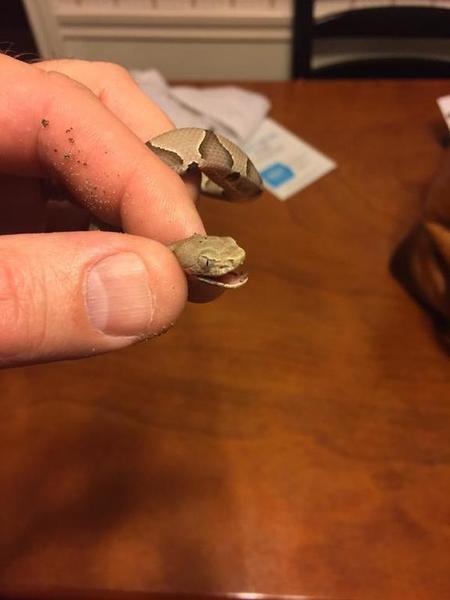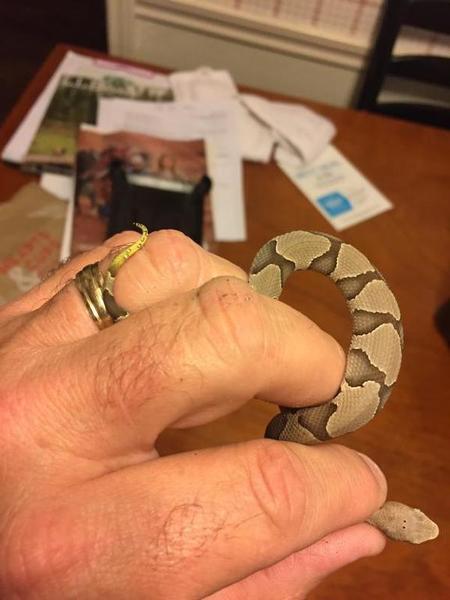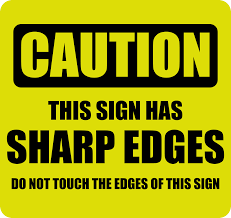Just wondering from the snake guru's...is that one big enough to be a problem for humans?
Thanks...Gman
Copperheads are born viable with venom glands and can certainly be a problem if bit.
They are often worse because they don't control there venom like adults. The short answer: No.
Full Column:
For all the fear and hatred they evoke, snakes inspire fascination like no other group of animals. Those that kill snakes on sight will eagerly take every opportunity to share stories of their encounters with serpents. Animal lovers will hold court with tales of large snakes they have seen and those they hope to find. And perhaps most interestingly, rational-minded people, even those that spend much of their time outdoors, will often believe the most far-fetched ideas about snake biology.
When it is revealed that I am a researcher that specializes in reptiles, I am often confronted by curious individuals wanting to know the veracity of a particular legend. Iíll never forget the woman who earnestly asked me whether I knew what kind of snake would grow into separate, fully-functioning individuals when it was cut into pieces with a garden hoe. I believe I noted that I wasnít familiar with that species.
They say that every myth has some basis in reality, so it shouldnít be surprising that there are some legends that seem more reasonable. Perhaps the question that I am posed most often relates to the relative danger of young versus adult rattlesnakes.
The legend goes that young snakes have not yet learned how to control the amount of venom they inject. They are therefore more dangerous than adult snakes, which will restrict the amount of venom that accompanies a bite. Itís repeated so often that itís become a sort of mantra among laypeople and biologists alike.
It seems like a simple enough suggestion, but to examine this topic requires some examination of the assumptions implicit within the framing of the question as well as delving into some hot topics in biology. There are four main assumptions when the question is framed in this manner: 1) snakes are able to control the amount of venom they inject, 2) there is some disadvantage to a snake when it injects all of its venom in every bite (otherwise why not inject all of their venom all of the time?), 3) as a result, a snake will learn of these disadvantages and change its behavior as it matures, and finally, 4) a full envenomation from a young snake is more dangerous than a partial envenomation from an adult snake.
First things first, can a snake control the amount of venom they inject? This is actually a contentious issue among snake specialists. There are some who believe snakes do indeed control the amount of venom they inject, they are proponents of what is considered the Venom Metering Hypothesis (among scientists, a hypothesis is a preliminary explanation of observed phenomena; these explanations havenít been rigorously tested. This is a step below a scientific theory, which is a conclusion based on observations and experimentation). Past studies have indicated snakes inject different amounts of venom in different situations, but the trends are sometimes inconsistent.
A recent review of studies on the subject suggested although some researchers have documented trends in venom injection, there isnít compelling evidence to suggest that it was necessarily controlled via any decision by the snake. They came to this conclusion because the trends didnít seem to indicate the amount of venom the snakes injected would have any consistent benefit in the wild. And if there was no apparent benefit in the wild, then why would snakes be choosing to exhibit this behavior?
An alternative hypothesis has been termed the Pressure Balance Hypothesis, which suggests the amount of venom a snake injects is due to a combination of snake anatomy and the properties of the object the snake is biting. This would explain why snakes tended to inject different amounts of venom into different targets with no clear benefit to the serpent.
For the purpose of this discussion, letís say that snakes can control the amount of venom they inject. The second assumption states there must be some disadvantage to a snake injecting all of its venom when it bites; otherwise, a snake would just inject everything every time. Why not?
This is another interesting question. It may be beneficial for a snake to keep some venom on hand in case its intended prey requires a second dose, or if a first prey item escapes and another quickly appears. Another scenario is that a snake does not want to inject all of their venom into their food just in case they are suddenly confronted by a potential predator of their own. Finally, it takes some time for a snake to produce more venom, and energy that goes into venom production is energy these animals could use for other important tasks, such as growth or reproduction. Consequently, common sense would suggest that there are some disadvantages to a full release of venom at every opportunity. It may be possible to confirm this suggestion via experimentation by testing whether snakes that frequently inject all of their venom experience slower growth, lower reproductive rates, or high mortality. To determine this would require a complex study, one that has not yet been attempted.
The third assumption states that as a snake matures, they learn there are disadvantages to delivering full venom loads during every bite and as a result, they change their behavior. For learning to occur, there must be positive or negative reinforcement. If we state that a snake may keep venom on hand in case a prey item (or one that appears shortly after the first prey item) requires a second bite, this snake must have experienced a number of incidents where they injected a fraction of the venom they had into a prey item only to have this prey item escape. Over time, they may learn that itís beneficial to keep some venom for a successful attack later. This may make sense superficially, but one might think that it would be more likely that the snake learns to inject more venom with their first bite and increase the chance of a fatality than saving venom just in case they experience another opportunity to bite their intended food again. A commenter has rightly pointed out that there are a number of other potential scenarios we need to consider as plausible.
If we state that a snake learns to withhold venom from their bites in case a potential predator quickly appears and attempts to eat them, a snake must have learned that itís somehow beneficial to do so. This snake would have had to experience numerous predation attempts and survive to know the costs associated with their venom injection behavior. If an ďemptyĒ snake were to be eaten by an owl or bobcat, then it would know that it shouldíve kept some venom (but itís too late to do anything about it because itís dead). For a snake to learn itís beneficial to keep venom ready, it would have had to survive an attack, and if it survived an attack without any venom left over from a previous feeding attempt, then I guess it didnít really need that venom anyway. So, by logically extending the third assumption, we find that itís difficult to envision a scenario that would enable a snake to eventually learn that itís beneficial to withhold the amount of venom it injects with their bite (check the Comments to read about why this sentence was misleading). Remember, it would likely require that this scenario happen numerous times for a snake to eventually learn the consequences of their behavior.
Itís possible that there are evolutionary advantages to a snake retaining some venom in case itís needed in a defense against an attack by a predator. Itís easy to conceive how snakes that tended to have venom on hand would be more likely to survive longer and produce young. If this behavior had a genetic component, the surviving snakes would pass on the tendency to conserve venom to their offspring. This is not learning however, and the behavior would be innate (i.e. something theyíre born with) or instinctual.
Finally, the fourth assumption states that a bite from a young snake that has no control over the amount of venom it injects is more dangerous than a learned adult. But, there are some big snakes out there, and just a fraction of their total venom capacity could be more than 100% of a young snakeís potential venom output. So, I donít think this final assumption is always valid.
To summarize, although itís possible that this legend is true and baby snakes are more dangerous than adults because they havenít learned to control the amount of venom they inject when they bite, itís safe to say this is unlikely to be the case. And, there's really no evidence to suggest it's true. Due to the complexities of the original question, I doubt this statement will ever be tackled in a manner that sufficiently addresses all of its assumptions. But until then, try not to get bitten by any venomous snakes, no matter how old they are.







